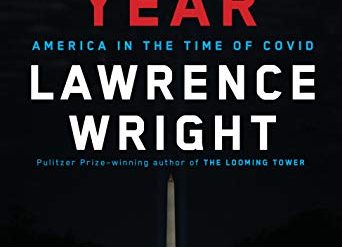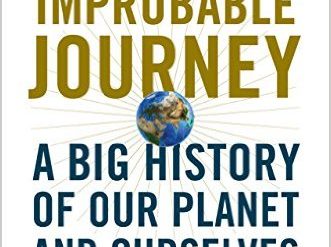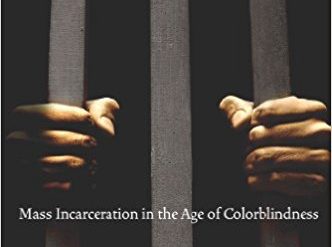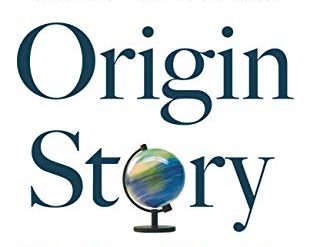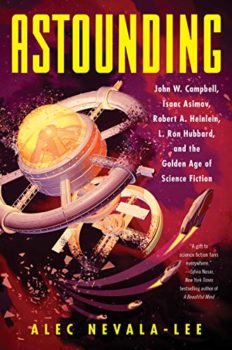
If you’re even a casual fan of science fiction, you’re surely familiar with the name Isaac Asimov, author of the Foundation Trilogy, “Nightfall,” and the stories collected in I, Robot. Asimov is often credited as the author of more published books than anyone else, even though it isn’t true. He wrote a mere 500. But Asimov is just one of the four luminaries who starred in what is called the Golden Age of Science Fiction, which is generally taken to span the years 1938 to 1946. That was the period when John W. Campbell, Jr., edited the magazine Astounding Science Fiction, and it’s the subject of Alec Nevala-Lee’s fascinating new history of the period, Astounding. Campbell himself, Asimov, Robert A. Heinlein, and L. Ron Hubbard are his subjects.
Estimated reading time: 6 minutes
Isaac Asimov, Robert A. Heinlein, and the man who made their careers
Nevala-Lee’s joint biography is unsparing. None of the four men profiled in Astounding comes off unscathed in this intensively researched book. Asimov was a sexual predator. Heinlein was a socialist in his youth but turned late in life to right-wing extremism, losing many friends in the process. Campbell was self-involved and managed to alienate many of the writers who had considered him a friend and mentor; later in life, he became obsessed with parapsychology and other pseudoscientific fields and crammed his magazine full of nonsense about them. And Hubbard? Hubbard was a paranoid schizophrenic, an abusive husband, a pathological liar, and a con man who drained nearly a billion dollars from the “Church” of Scientology. And I lost count of the number of wives among the four. There were at least eight.
Astounding: John W. Campbell, Isaac Asimov, Robert A. Heinlein, L. Ron Hubbard, and the Golden Age of Science Fiction by Alec Nevala-Lee (2018) 544 pages ★★★★☆
Still, there is no denying the brilliance of these four men. Campbell and Asimov were child prodigies, and Asimov’s IQ was “off the charts.” Heinlein and Hubbard were both articulate and achieved great success as writers. Collectively, their contributions to the science fiction field were beyond measure. In the final analysis, the author writes, “They hadn’t predicted the future—they had made it.” And, as Nevala-Lee points out, Campbell was the linchpin. He tutored Asimov as a young man and fed him the ideas for some of his best-known stories. He provided both Hubbard and Heinlein with an outlet for their views, and with the money that helped support them and their wives.
Isaac Asimov: “an experiment to develop a writer from scratch”
Some of the most intriguing passages in Astounding involve Isaac Asimov. The man who would become “the most prolific author in American history” approached Campbell with a short story for his magazine when he was a pimply-faced kid of 18. (Campbell bought his ninth submission, after a rewrite. Asimov was 19.) Rejecting story after story, Campbell at length “too him on as an experiment to develop a writer from scratch, feeding him the premise for his landmark story “Nightfall,” the psychohistory of the Foundation series, and the revolutionary Three Laws of Robotics.” These are the three works for which Asimov remains best known today.
Asimov was a decade younger than Campbell, Heinlein, and Hubbard. For many years, he was treated with grudging respect at best and disdain at worst. At one point, Heinlein even referred to him as “that idiot kid.” Asimov came into his own in the science fiction only many years after World War II, despite his having written most of the stories that would later sustain his fame in the field. And it was only in the 1950s, when he turned to writing popular science for young adults, that he gained fame among the general public.
An Astounding history of science fiction
During its peak years in the 1940s, Astounding was the leading publication in science fiction. The magazine had the largest number of subscribers, and it paid its authors more than any of its competitors. As a result, Nevala-Lee’s book abounds with names that remain famous to fans of classic SF today: not just Asimov and Heinlein but Jack Williamson, Theodore Sturgeon, A. E. van Vogt, Frederik Pohl, and many others. Nearly all the top names in the field sold stories to Campbell. Ray Bradbury was a notable exception. The book may best be described as an Astounding history of science fiction.
My journey through science fiction
The careers of the writers portrayed in Astounding all began in the 1930s and flowered in the 40s. However, my own experience as a science fiction fan didn’t begin until I turned 10 in 1951, so both Isaac Asimov and Robert Heinlein were big stars when I was a teenager. But I read little of their work. I was more attracted to others then, including Theodore Sturgeon, Ray Bradbury, and A. E. van Vogt. And in the 1960s, when I returned to reading science fiction, I gravitated toward the work of Arthur C. Clarke, Ursula LeGuin, Larry Niven, Samuel R. Delaney, and Philip K. Dick, among others—as well as Heinlein’s Stranger in a Strange Land.
That was the period when I began writing science fiction stories and, once I’d published a few short stories, joined the Science Fiction Writers of America in the 1970s. (It’s now the Science Fiction and Fantasy Writers of America, or SFFWA.) And I can’t resist noting that Analog Science Fact and Science Fiction, Astounding‘s new name, published one of those stories.
Although Alec Nevala-Lee writes exclusively about Astounding and the other pulp magazines, and to a much lesser extent about television, I became immersed in science fiction exclusively through paperback books. The author’s failure to acknowledge the rise of paperbacks as an outlet for the field is glaring. But, in other respects, the book is surely must reading for any serious sci-fi fan and a major contribution to scholarship about the genre.
For related reading
For more good reading, check out Great sci-fi novels reviewed: my top 10. And for a journey through some of the early stories of the iconic names in the genre, see The Science Fiction Hall of Fame, Volume One 1929-1964 edited by Robert Silverberg (Reassessing the Science Fiction Hall of Fame).
If your taste runs to the dark side, you might be interested in The top 10 dystopian novels reviewed here. You might also take a look at my own book on the topic, Hell on Earth: What We Can Learn From Dystopian Fiction. My book reviews 62 dystopian novels.
If you’re drawn to biography, check out Great biographies I’ve reviewed: my 10 favorites. You might also be interested in reading about two books that explore the life of L. Ron Hubbard and the Scientology movement he founded:
- Going Clear: Scientology, Hollywood, and the Prison of Belief by Lawrence Wright (Scientology revealed in a definitive investigative report); and
- Inside Scientology: The Story of America’s Most Secretive Religion by Janet Reitman (Set up your own religion, and make a billion dollars).
And you can always find all the latest books I’ve read and reviewed, as well as my most popular posts, on the Home Page.


